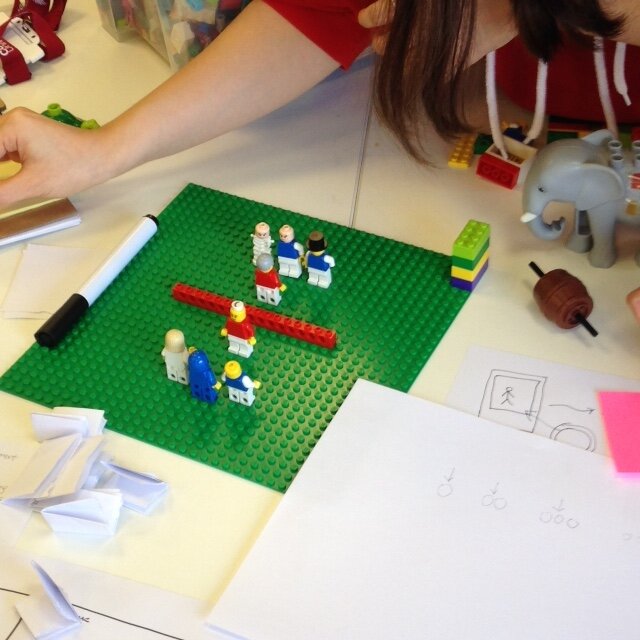Using visual and material methods to support your writing
For the 2020 MethodSpace AcWriMo we aimed to catalyze new thinking about Publishing Trends (and what they mean for academic writers.) One trend we discussed is toward the digital, and another is toward creativity. These two trends intersect when we communicate visually. Non-text types of communication are essential online, since the Internet is increasingly a visual medium.
Why visualise your writing?
Very few people would say that they find writing easy. You might find it satisfying and (if you’re lucky) enjoyable, but most of us would also say that we find writing rather difficult. Whether we are writing for an academic publication, thesis or a friend’s birthday card, it can be a struggle articulating all we have to say through the written word. So what if we don’t make words our only focus? What if we can harness visual and material techniques to support and illustrate our writing?
In this article I will explore how visual and material techniques can help you in two ways.
1) visual techniques help you think about your writing differently;
2) visual techniques can help you disseminate your ideas effectively.
After all, a picture is worth a thousand words.
I have a multidisciplinary background in both design and the social sciences, which might be why I’ve always incorporated visual and material techniques into my writing process. At the most basic level, I always have at least two notebooks on the go. One is for tasks and meeting notes and another is a reading and ideas log to go with whatever writing task I am working on at the time. When I started my PhD back in 2011 I really struggled with the new sociological theories I was confronted with. So, along with my reading notes, I started to draw the key concepts. For example, I spent many long afternoons poring over Bourdieu, after it was suggested that Bourdieu’s theories could provide a constructive way for me to understand the social phenomenon I was studying (and so began a long, one-sided love affair with Bourdieu, but that’s another tale). By literally trying to draw or sketch out Bourdieu’s theories of social and cultural life, it helped me to comprehend those concepts and ultimately, write about them. It didn’t matter what the sketches looked like or if anyone else could understand what it was, for me it was part of my thinking process. It enabled me to develop my own knowledge structures around these concepts and how they linked to my PhD topic.
I also love mind maps and flow charts. Almost every piece of writing I do, whether a thesis chapter, publication or blog post, starts as a mind map. By writing key points down in no particular order, my mind is free to formulate thoughts in any way it sees fit. I then add arrows, lines, asterisks or color, to add order and structure to these thoughts. Post-it notes are also useful for this process. Sometimes these maps make their way into a formal output, but often they are for my benefit only.
COVID restrictions probably mean you are working from home more, perhaps without access to a printer, and also without access to face-to-face workshops and writing support. As we do everything online now, it is easy to forget that writing doesn’t just have to be between you and your laptop. Sometimes it is beneficial to take a step back, pick up some colouring pens and think about your writing in a different way. With this in mind, here are some thoughts and tips to shake up your writing practice:
Using visual techniques to help with your writing
As I have already said, I find mind maps a very useful technique to get a writing project started. And these are informal, messy, hand-drawn mind maps. If you are lucky enough to have access to your own whiteboard, then that just adds to the fun. You can also shun words altogether and instead, draw. What shape does your writing have? Can you represent your writing in an image? Don’t be precious about these pictures, no one else has to see them, they are simply an aid to the thinking process. Such techniques can force you to think about your key message and how your writing fits together.
Academic developers recognise the value of using visual and material methods to think through writing. LEGO workshops and the ‘Bake your PhD’ competition are testament to that. I have both attended and hosted LEGO play workshops and find that, more often than not, attendees gain something from their participation. For many it means stepping out of their comfort zone, but for those that do, they gain a fresh perspective on their writing and chance to reflect.
Not every technique will work for everyone, and maybe you won’t find any of these things helpful, but the important thing is to give yourself permission to play.
Using visual techniques to disseminate your writing
Visual techniques are also very useful for disseminating your research. Creative dissemination can support public engagement and research impact, and also makes for a neat way to share your research on social media. To turn those messy mind maps into something presentable I recommend Miro. It’s a free, online tool that can help you create professional maps and flow charts useful for providing a summary of key ideas. The more artistic among may even want to use drawings or cartoons to showcase your research, as demonstrated by this previous MethodSpace blog post.
Why not share your thoughts, sketches or adventures with LEGO under the #acwri twitter tag?


